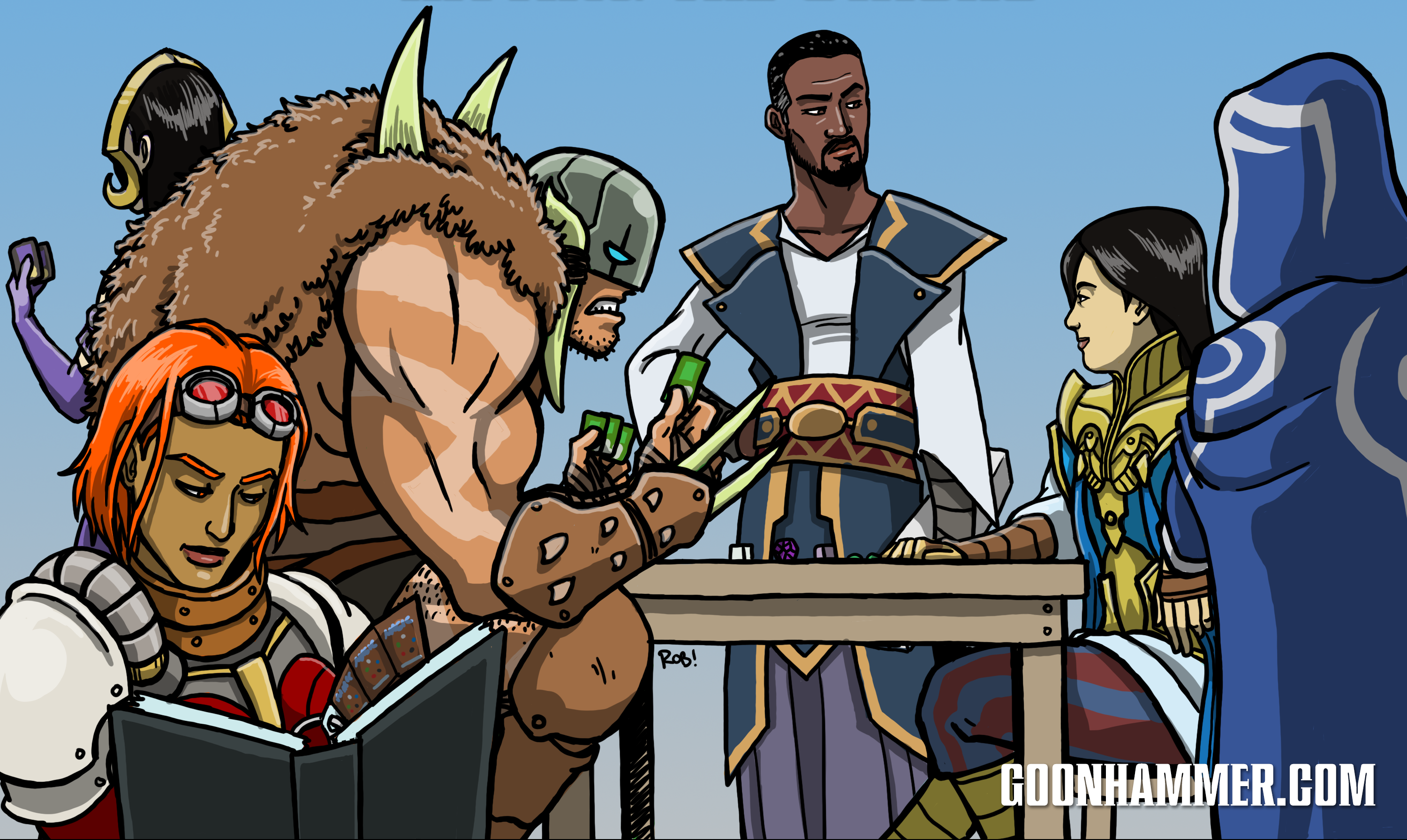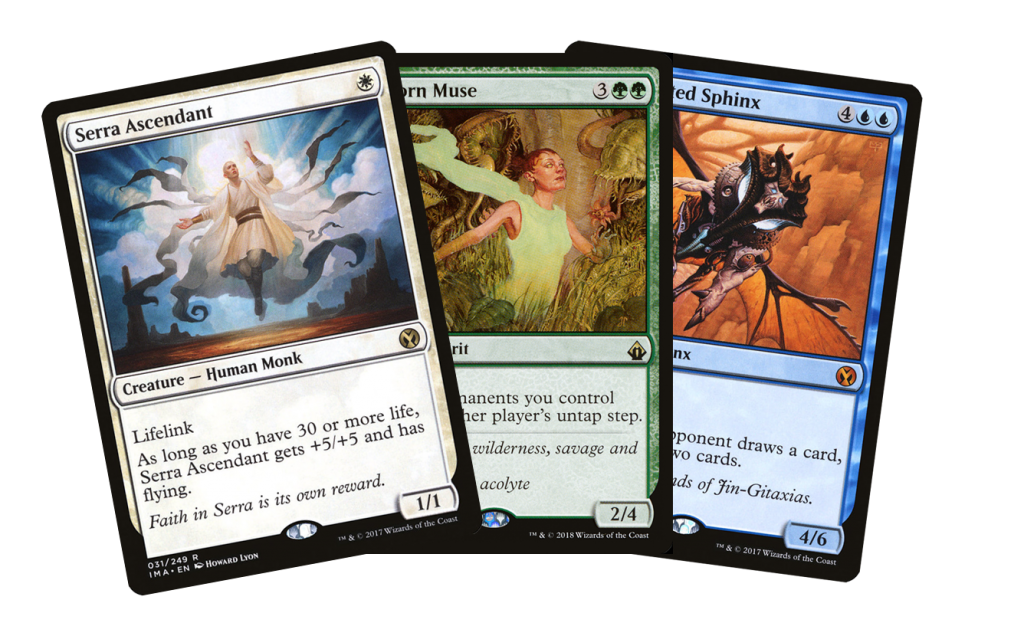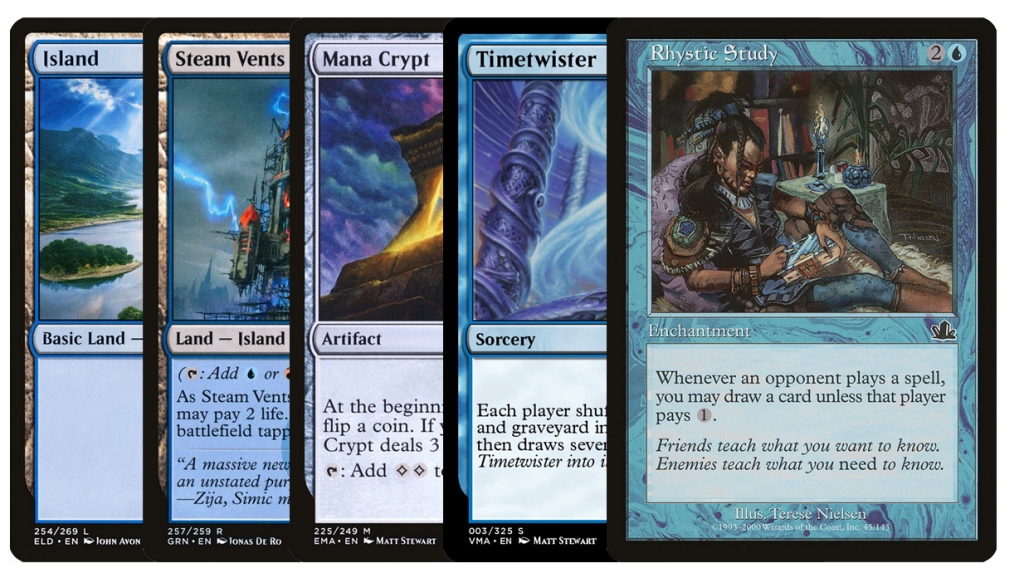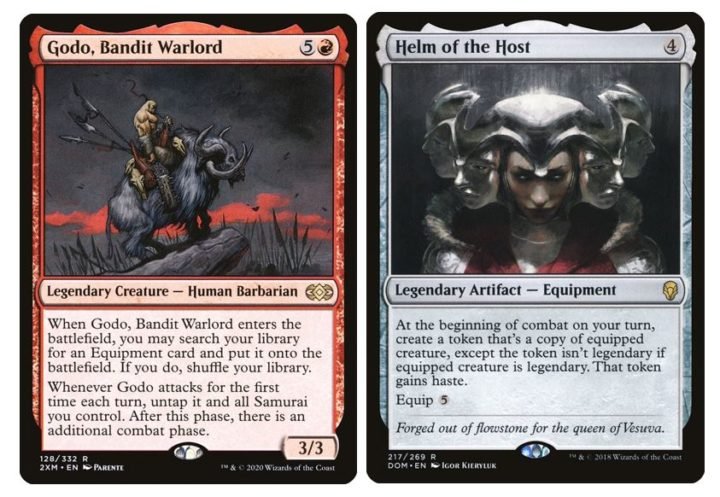In this week’s Commander Focus we’re kicking off a limited multi-part series on the basics and core principles behind Magic’s Commander format. Each week we’ll cover a different key element and dive into the dynamics behind it and how you can apply the principles laid out to your games. This week we’re talking about winning the game.
Generally speaking, traditional magic relies on a basic one-to-one relationship with the opponent and their resources. You have a card, you try to trade it for a card. Value decks try to trade a positive ratio to generate card advantage, perhaps 0.75 to 1. If you can trade 3/4ths of a card for an opponent’s card over and over or consistently generate 2-for-1 trades, you’ll find yourself up several cards. If this ends up meaning that you have a creature on the board and a bit of protection for it, you can turn that bad boy sideways a few times and end the game.
You can see this in the basic relationship of cards in the game’s original Alpha/Beta sets. Early Magic established a number of common ratios, some of which still hold up today, such as the conversion rate of 2 generic to 1 colored mana or the raw 1+x trade of mana for damage in Fireball, Disintegrate, Earthquake, Drain Life, or Hurricane, and some of which do not hold up so well, like the 0-for-1 tradeoffs of the Moxes or the 1-for-3 tradeoffs of Ancestral Recall or Dark Ritual. Early Magic introduced a number of cards which made one-for-many trades possible, such as the aforementioned Earthquake and Hurricane, Balance, and Wrath of God; theoretically these cards avoid creating blowouts by affecting “all” of a thing, and thus hurting both players equally. But players quickly learned that with proper timing and building these effects can break the standard ratios wide open, letting a player reset the board and generate significant advantage off a single card.
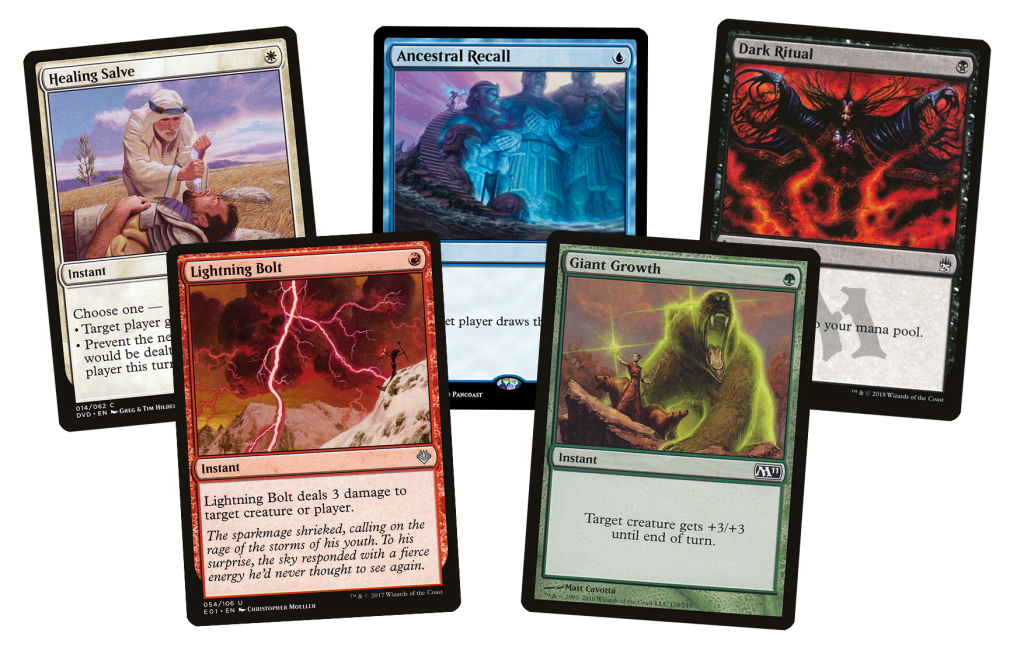
Taking advantage of these effects requires building a deck specifically around the idea of preparing to “reset’ the board. You see this often in Control decks, where the goal is to win via attrition and card efficiency, classically “trading up” and resetting the board to regain control of the game state when things get dicey. More aggressive archetypes eschew card advantage and may make bad trades in favor of damaging the opponent so fast that they can win before the opponent can stabilize and the effects of card disadvantage are actually felt.
What this all comes back to is that traditional Magic is a zero-sum game: Either you win or your opponent wins (excepting the very rare draw). Traditional card advantage strategies are built around the idea of getting small card advantages over the opponent by making a series of marginally advantageous trades and avoiding giving them up to your opponent. After all, you just need to stay ahead of one other person to secure an advantage during a game.
At its most basic, fundamental level, however, Commander/EDH throws all this out the window. Put simply, Commander is a negative-sum game – there are four players, and only one can win.
Think about that for a moment, because while that seems obvious the immediate consequences of it are not so clear. In traditional 1on1 Magic, being a “good” player or having a “winning” deck may mean winning 60% of the time. Parity – winning your “fair share” of games means winning 50% of them. It’s always important to play to not lose, because as long as you don’t lose, you can still win. Anytime you’ve blocked your opponent from a win you still have a chance to take home the W. Parity in Commander would mean winning 25% of your games. That means losing most of your games. And not just a small majority – this means losing 75% of the time. Which is to say that if you expect to lose every game of EDH you play, you’ll be right more often than wrong. In the world of games and game theory this can be a strange notion.
Regular Magic is a zero-sum game because each of your wins is balanced by a single opponent’s loss – your +1 win to their -1 win. But in Commander your win is balanced by 3 losses.
So what does this mean for you, the person playing?
You have to value cards differently.
Most of the games we see modeled, in media, sports games, etc. – involve head-to-head competition, one on one. But in every aspect of play in commander we have to keep in mind it’s fundamentally a game of one winner and three losers, and a game with three adversaries. This makes card selection is a completely different process, in part because we have to look at the expected value of our choices differently. One-for-one trades are acceptable in one-on-one Magic but they’re much less so in Commander; each one-for-one trade creates a situation where you and one opponent are each down one card from your other two opponents. Even with marginal positive value you’re coming out behind against the field. Additionally, threats left on one opponent’s side of the board may be used against other opponents, creating advantage for you. While removing threats may be a priority in one-on-one Magic, it’s much less important in Commander, where killing things – particularly in one-for-one trades-is something you want to avoid unless you absolutely have to. This means that when evaluating cards, a large number of spot solutions and cards that eliminate single threats become less desirable unless they’re incredibly efficient or versatile – You’ll still need to include some of these – you will still need to prevent an opponent from outright winning the game on occasion.
There’s also the reality that the card quality of Commander is very uneven. Arcane Signet is simply better than Fellwar Stone. There might be a few rare situations where Fellwar actually ends up being more useful, but in almost every instance, if you could choose which to draw, you’d choose Arcane Signet. Timetwister is one of the power 9, and yet is legal, allowing you to fill your hand with 7 new cards for three mana. There are tradeoffs between Demonic Tutor and Vampiric Tutor, but Imperial Seal is definitely worse than either. And some cards generate significantly more value in Commander thanks to either the rules of the format – starting life totals make Serra Ascendant one of the game’s most efficient creatures – or because of having multiple opponents, where Seedborne Muse and Consecrated Sphinx will activate during multiple opponents’ turns, driving a ton of value for you. Though even this extra value may not be enough to make them playable in your deck.
Rhystic Study, a card that is arguably barely playable in standard 1v1 games is one of the strongest cards in Commander; and this leads to one of the realities – tax cards, in general, are very strong. More on that in a future post. Likewise, repeatable and permanent effects also tend to be more powerful – repeated draw is slower but more valuable in Commander than one-off draw spells.
Because of the card quality issue, and the tight nature of many Commander combos, I think it’s also false to rely on something like aiming for 3:1 trade-offs/returns, or thinking of the game as one in which you can use cards like Tanglewire all that effectively. Yes, in theory, tanglewire makes your opponents tap TWELVE permanents and then you only tap 2 (and the tanglewire), and then they tap NINE and you tap 1, and then they tap THREE and then you tap none. So they’ve tapped 24 permanents and you’ve tapped 3, but you’ve also spent a turn dropping out a tanglewire, and you’re now probably down a card, and one of them may well have been able to get their combo off even while tapped out, or execute their combo during their upkeep, or just blown up your tanglewire right before their turn, leaving your two theoretical allies (enemy of my enemy and all that) tapped out while the player to your right successfully ends the game. Coincidentally this is largely the issue with two of the Teferi cards – Yes, Teferi prevents your opponents from casting spells on your turn, but they also can’t cast spells during your other opponents’ turns, meaning that you are forced to be the one stopping each opponent from doing as they wish. Effectively you’ve silenced 2 players, but not the active player. This means resolving Teferi, Mage of Zhalfir should be probably be left to your predator’s (specifically, this means the player to your right) end-step, in preparation for your own infinite combo.
So as you evaluate Commander cards, give some real thought to whether the cards you’re adding to your deck replace themselves and generate real value in a multiplayer environment. Look for repeatable effects and cards with an individually high power level or versatility that help you generate or maintain card advantage.
Use your Mulligans aggressively.
Because you can only expect to win ~25% of the time, and card quality is uneven, one of the first conclusions it’s easy to draw, is that we should probably consider using our mulligans fairly aggressively. Don’t just look for a playable hand, look for a hand that’s good, with a strong card that can give you advantage, or take a very playable hand. Some basic combinations are very strong:
Mana Crypt + Land + Timetwister
Mana Crypt + Land + Wheel of Fortune
Mana Crypt + Land + Rhystic Study
Mystic Remora can be out of control, especially if you go first.
Mox + Land + Mana Crypt + Smothering Tithe is also incredibly strong.
So what should you be looking for in an opening hand?
Ramping into card advantage is frequently one of the best ways to go. If you can bust out an early Tymna or another draw source, this is worth using a mulligan to get into. You may throw away a “playable” hand but that may well have been a game you would’ve lost anyway. And even if you mulligan down to 6, 5, or even 4, if it’s the right for, that can easily be playable, even stronger than an adequate, playable, starting seven, with no particularly strong lines, just some lands and okay cards. This is part of why so many strong decks contain card advantage in the command zone – all you have to do is look for enough ramp to start gaining cards and you’re off to the races.
You have to play to win the game.
If you’re about to win, and an opponent wins, you lose. If you are nowhere near winning, and an opponent wins, you lose. But you haven’t lost anymore than the guy who almost won. To put it simply, 2nd, 3rd, and 4th place in Commander are all the same. This is part of why an “okay” hand or a “playable” hand is worth a mulligan for a truly “good” hand: You want to have a significant ramp and card draw, or a combo piece, or a tutor in your hand. If you look at deck primers for cEDH they always feature a section on what hands to keep and what hands to take. Most times Commander players seem to play the “One free mulligan” rule combined with the London mulligan rule. This is quite generous, but it means that you should probably be averaging more than one mulligan per game. Before the game even starts you should have generated a checklist of hands you’ll keep and hands you won’t. One of the easiest ways to do this is to give cards in your deck a mental point value, and mulligan unless you have a certain point value in your opening hand.
Once the game starts, your plan has to be to win. Not beat one opponent, not beat two opponents, not eliminate an opponent or two, but to win the game. It’s not enough to have a general plan to turn some creatures sideways, or hope your opponents will whittle each other down while you play defensively, allowing you to swoop in for the victory when the time is right (particularly given how many fog effects in the game). You need to have a plan for winning the game outright. The most effective way to do this is to build toward a combo or setup that allows you to win the game in a single turn.
Going back to our original article on building a Commander deck, you have to think about your deck’s purpose during the building stage. When building your deck, ask yourself:
- Step 1: How will I end the game (win)?
- Step 2: How will I get the pieces to end the game?
- Step 3: How will I protect my tutors or draws, and prevent others from winning?
- Step 4: How will I power my tutors, draws, and protection?
Playing to win means building to answer these questions and, in a game context, consistently executing each of the four steps – identifying how you will win, assembling the pieces to do so, preventing others from winning and assembling theirs, and protecting your own means once it’s time to complete the cycle. We also noted the increased difficulty in winning a game of Commander – having three opponents means you need to deal triple the damage (120) and mill triple the cards (276). As a result, it’s often easier for decks to “combo off,” or set up a game state that can be repeated endlessly, either causing damage, loss of life, or targeted draw, to create the volumes required to win in a single turn. You may also prioritize cards that offer alternate win conditions or cards that cause opponents to lose the game (and can also be repeated).
You have to build around winning the game decisively.
Some cards are kind of good all the time, some cards are situationally good, and some cards are only good as part of a combination with another card, when the synergy generated by the combination creates additional value.
Melira, Sylvok Outcast and Devoted Druid are both mediocre cards, but together they give you infinite green mana. As a singleton game, EDH relies on pulling off such combos. Probably the most common win condition in competitive commander relies on decking yourself and then winning, rather than losing as you normally would, when you do it. Thassa’s Oracle, Jace, Wielder of Mysteries, and Laboratory Maniac all generate such an effect, and they’re coupled with Demonic Consultation and Tainted Pact, but this is an all or nothing strategy, if someone manages to Stifle your trigger or kill your lab-man, then you’ll lose off exiling your entire deck. But the combo package is so tight and consistent, that you see it everywhere. It probably helps that it’s cheap, and it only requires 2 colors in your identity, and both Jace and Thassa are useful on their own, and consult and pact are tutors. The barriers to winning are also quite large, as well by more normal means are quite large, as well.
In Magic terms, doing 20 damage isn’t so hard. Getting a creature to 10/10 and giving it double-strike is doable. Attacking over 2 or 3 turns, averaging 7-10 damage per turn, very doable. But in Commander, that 20 life becomes 120. And it’s inordinately easy to gain life. So simply going wide and dealing damage over time with creatures is no longer as functional. Add to that the fact that board wipes essentially functionally as asymmetric effects, especially if your deck is built to recover from them or built around not having creatures. It’s not that unusual to see artifact-based or enchantment-based decks in Commander, and at the same time, since most decks rely on a 2-3 card combo that can be repeated endlessly and many good decks see the graveyard as a useful place to stash combo pieces before putting them into play, you’ll see a Wrath of God or a Toxic Deluge pretty often. Thus, building up the kind of board state that can churn out creature damage is difficult and fraught with setbacks and peril. And killing two opponents and leaving one alive may well make you vulnerable to a return masterstroke. The way commander is scored right now, if you kill off two opponents and your final opponent resolves a “win the game” card, you lose just as decisively and completely as the other losers, even though they are players you killed off.
Similarly, milling your opponent for 40-50 cards isn’t actually that difficult. Most players want to draw cards, and some of the most common mill effects are repeatable but trying to mill out 3 opponents at 100 cards each, conservatively you’re talking about needing to mill 240 cards. The most likely way to do something like that is Bloodchief Ascension and Mindcrank, which is liable to kill your opponents before they are decked in any case.
This all leads to the strategy of generating “a lot, but not infinite” of something (damage, milling, card draw) not working all that well, and why so many successful Commander decks rely on assembling “you win” conditions or else rely on doing something infinitely. There are exceptions, such as Yuriko, tiger’s Claw, but cards like Yuriko have an innate tripling effect, where the card you are drawing and revealing is automatically tripled.
There’s also a kind of meta note that is worth consideration since we’re not living entirely in the realm of game theory, but rather in the realm of the theory of playing games with players who you may be friends with or see over and over again at the local game store. Taking out one player is kind of not fun for that player. If you gather to play commander and someone gets killed off early, they might conceivably be reduced to being a spectator for 30-40 minutes while board states proliferate. This is one of the problems in my view with decks such as one-punch or other decks that can pretty consistently make one player lose. Dishing out 21 commander damage isn’t that difficult, but sadly there’s no reward for doing so and the potential for hurt feelings for the player removed.
So to play Commander effectively you want to play cards that let you end the game once and decisively – “Never do your enemy a small injury” might be a good adage here. Additionally, generating the kind of board state that allows you to kill one player but not all of them frequently makes you an immediate target for whoever’s left. If you’ve demonstrated that you can kill off a player, perhaps by using a Voltron strategy, then you are inherently threatening to do so to the remaining players, and they should – and will – use all their resources to stop you.
Next Time: Resource Disparities
That wraps up this week’s look at Commander strategy but check back in next week when we continue to talk theory and strategy and look at resource disparities and tax effects, talking about the impact they have on the game. In the meantime, if you have any questions, feedback, or requests for future articles drop us a note in the comments below or email us at contact@goonhammer.com.
